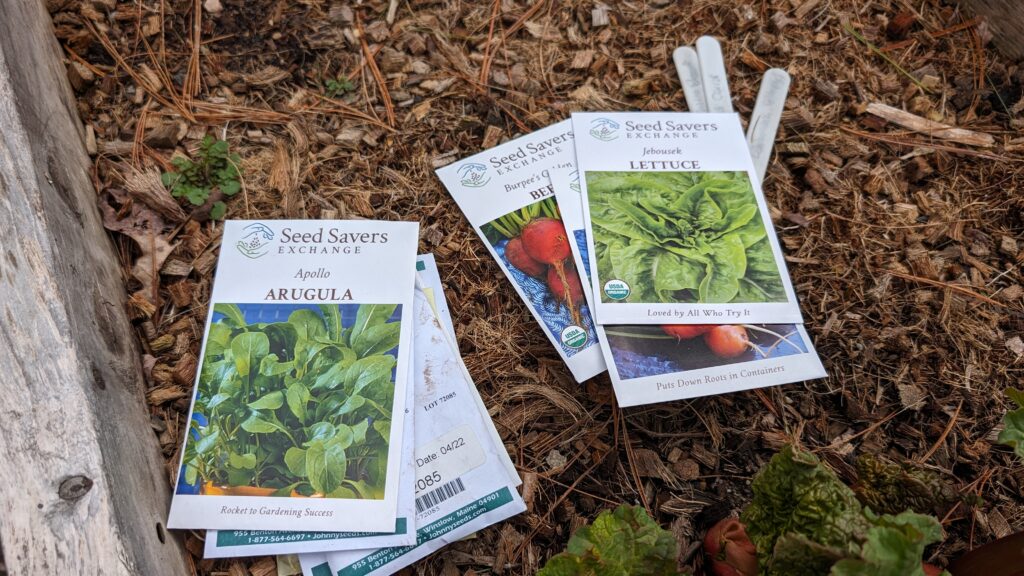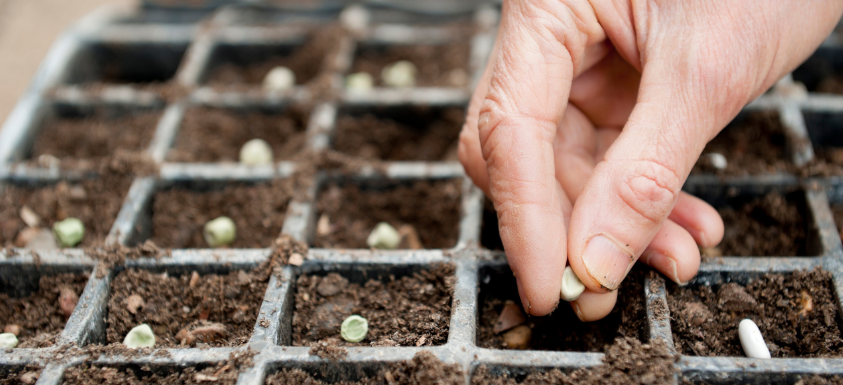March is a transitional month in the gardening calendar. It’s a great time to start preparing your garden for spring. Since spring usually ends up being a very busy time in the garden (if not the busiest time), it’s a good idea to get organized early. That way you can plan and spread out the tasks that need doing without getting overwhelmed. Gardening should be fun, after all! To help you get organized, we’ve put together an easy-to-follow spring garden checklist to you prepare for the upcoming growing season.
Don’t forget to check out our FREE seed starting guide!
Tasks for Warm Climate Gardens
In warmer gardening zones your spring garden checklist can start focusing on what plants can get into the soil. Since temperatures are generally warming and daylight hours are increasing in March, your garden will start to come alive very soon!
1. Direct Sowing Early Season Crops
Check you seed packets for those early season crops that can be direct sown. Before sowing, check your soil conditions. You’ll need to wait until the soil isn’t too cold or too wet.
- Dig down about 2 inches to test the soil conditions.
- Test soil temperature – should feel cool but not cold to the wrist.
- Check soil moisture – soil should form a loose ball when squeezed, without water seeping out.

2. Pruning and Plant Management
Late winter and early spring are a great time to prune trees and shrubs to them ready for spring. It’s also a great time to consider dividing perennials to multiply the number plants you have in the garden. Focus on these key maintenance tasks:
- Prune trees and shrubs, removing dead material back to the nearest live growth point.
- Look for any branches that are rubbing together or are growing inward toward the center of the plant. These branches should also be pruned back.
- Divide perennials as they emerge from winter dormancy.
- Replant divided perennials promptly to ensure good establishment. If you can’t get the into the ground right away, just pot them up and keep an eye on them for water and sunlight until you can replant them in the garden.
3. Starting Warm Weather Crops Indoors
Depending on your last frost date, it might be the perfect time to start warm weather crops indoors. Starting plants like squashes, cucumbers, corn and beans can help you get a head start when the temperatures really warm up. Be sure to fertilize and pot on your other warm weather veg like tomatoes and peppers, too.
4. Fertilizing and Soil Preparation
We like to fertilize our perennials in early spring.
- Look for an organic, well-balanced fertilizer, like a 10-10-10 or 5-3-3 or similar. At this stage you just want to get additional nutrients into the soil. Once you’re plants are off and growing you can consider more specific fertilizers. That said, using a simple liquid seaweed during the growing season is a good way to feed hungry plants without over-doing it.
- Always follow the application directions on any fertilizer you buy. Generally, I like to sprinkle the fertilizer around the outside of the plants and scratch it into the soil.
- Keep an eye on the weather – don’t spread fertilizer before a rain storm or you risk the fertilizer washing away from your plants before it gets into the soil.
- To prep my vegetable beds for the season I like to mulch them with either compost or grass clippings that will break down through the season and feed my plants.
Tasks for Cold Climate Gardens
In colder climate areas, snow and below freezing temperatures will mean that most outside gardening will have to wait. But there are a few key things that should be on your spring garden checklist.
1. Indoor Seed Starting
Check on the average last frost date in your area and time your indoor sowing based on that date. Just know that your actual last frost may be sooner or later than the average. Don’t plan to put to seedlings into the ground until you’re confident that there’s no more frost in the forecast.
Here in zone 6a, March is a good time to start pepper and tomato seeds indoors:
- Start peppers about 8 weeks before last frost.
- Begin tomatoes approximately 6 weeks before last frost.

2. Winter Sowing Opportunities
If you still have at least a month of colder temperatures (and if you are zone 2-6 you probably do) you can still do some winter sowing:
- Sowing cool weather vegetables like cabbages.
- Starting perennials that need a 30-day chill period.
3. Tool Maintenance
Take this time to sharpen tools, clean, and oil them before getting back outside for the season.
- Use a sharpening stone and tool oil to get your tools sharp and ready to perform at there best. If you find any rust, you can use steel wool to gently remove it.
- Don’t forget about your lawnmower blades. They need sharpening, especially if they got heavy use during the summer. A sharpening stone or file works well. Hang the blade by the center hole on a nail to make sure it’s balanced (and that you didn’t remove more material from one end versus the other). If you’re unsure, find a local hardware store or other knife sharpening service and ask if they can sharpen your mower blade.
- Check any fences you have around the garden to make sure they’re secure before planting out your precious vegetables.
4. Late March Activities
As temperatures warm:
- Test soil temperature and moisture levels
- Prepare garden beds for planting
- Plant cool-weather crops like peas and radishes when conditions permit
Check out our springtime gardening videos on the Frog Pond Gardening YouTube Channel. Don’t forget to click that subscribe button so you never miss a new gardening tip!
Remember, regardless of your climate zone, March is an important preparatory month that sets the foundation for a successful growing season. Focus on the spring garden checklist appropriate for your area, and you’ll be well-positioned for spring gardening!
COMMENTS